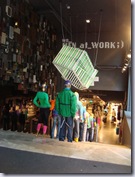The psychologist Jean Piaget studied how people develop knowledge, the ways that we explore our environment to gain better understanding of the world and to acquire more sophisticated skills. He identified two types of learning, assimilation, in which we learn how new experiences fit into our existing understanding, and accommodation, in which we adapt our mental models to fit new experiences. In effect, one’s grip accommodates a stone, while clay is assimilated into our grip. Assimilation and accommodation work in synergy with one another, like pendulum swings that, over time, advance our understanding of the world and our competency in it. (Boeree)
 The first week in a new location is a learning adventure in exactly this way. Knowledge from Arnhem is certainly relevant to finding my way around Maastricht. For example, the train station works the same old way, and only the geography changes. There are familiar names (with familiar functions) everywhere: the Albert Heijn (groceries) and Blokker (housewares), the neighborly Tom Mullins (pub) and the gargantuan Ikea Woonboulevard (furniture).
The first week in a new location is a learning adventure in exactly this way. Knowledge from Arnhem is certainly relevant to finding my way around Maastricht. For example, the train station works the same old way, and only the geography changes. There are familiar names (with familiar functions) everywhere: the Albert Heijn (groceries) and Blokker (housewares), the neighborly Tom Mullins (pub) and the gargantuan Ikea Woonboulevard (furniture).
 But there are also unique finds in Maastricht that will change how I live. There is an amazing bookstore, Selexyz dominicanen, fit inside of a cathedral nave. Finally I won’t have to go to the UK or US for books: a welcome change to my habits. My new gym, the Il Fiore healthcenter, features a computer system that automatically keeps track of my cumulative
But there are also unique finds in Maastricht that will change how I live. There is an amazing bookstore, Selexyz dominicanen, fit inside of a cathedral nave. Finally I won’t have to go to the UK or US for books: a welcome change to my habits. My new gym, the Il Fiore healthcenter, features a computer system that automatically keeps track of my cumulative  activity on every cardio- and weight-machine. I’m not used to monitoring my progress that way; its a bit like using the casino cards that dispense comps when I’ve lost enough money.
activity on every cardio- and weight-machine. I’m not used to monitoring my progress that way; its a bit like using the casino cards that dispense comps when I’ve lost enough money.
And there are the many changes when learning to live in a new apartment.
Most are just simple adaptations: fitting my morning routine to the new kitchen layout, or boiling hot water instead of getting it from a tap (okay, Arnhem spoiled me on that one), or having to walk to the car parked a quarter mile from the apartment. Others take some learning: I still stub my toes on things that are out of place in the bathroom, fumble for light switches in unfamiliar locations, struggle to balance heat from radiators absent a central thermostat.
 Stewart Brand’s How Buildings Learn is a classic text that shows how buildings evolve in sympathy with their occupants. We, in turn are equally shaped by the neighborhoods and services that surround us. It really is a pendulum swing between the ways we live and the ways we grow.
Stewart Brand’s How Buildings Learn is a classic text that shows how buildings evolve in sympathy with their occupants. We, in turn are equally shaped by the neighborhoods and services that surround us. It really is a pendulum swing between the ways we live and the ways we grow.






